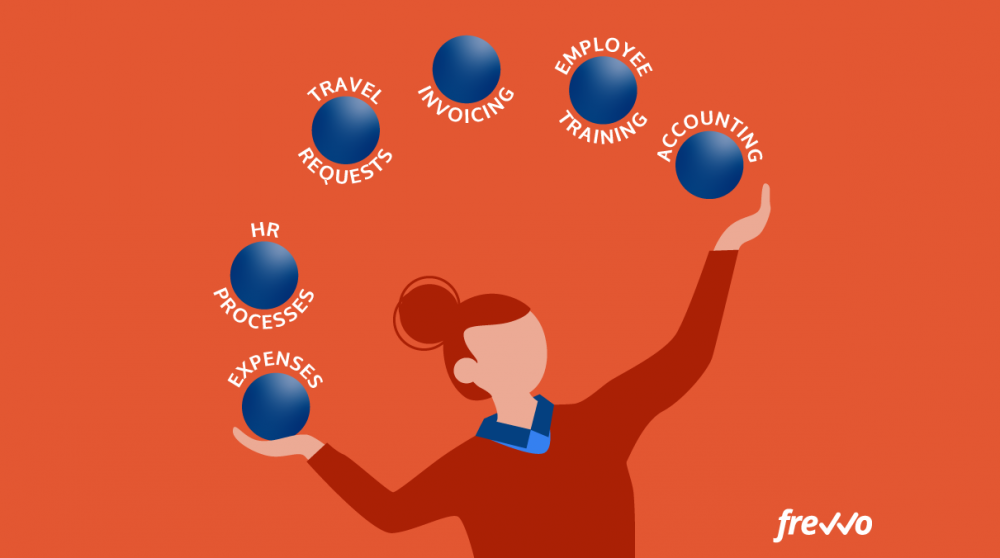Business process automation (BPA) involves streamlining and automating the everyday workflows involved in the business operations of every organization. These range from everyday administrative processes like data entry to HR processes like onboarding, to financial processes like accounts payable. BPA can be instrumental in optimizing operational efficiency, saving business time and money while significantly improving job satisfaction.
But how much does business process automation actually cost? Unfortunately, the answer is not so clear cut.
It will depend on the type of solution you choose (point solutions vs. enterprise automation), the number of users, and what processes you want to automate.
With so many variables to consider, however, calculating costs can be somewhat confusing. Add to that, time is not on your side as every second your employees spend on manual tasks, you are losing money. Especially during unsettling economic times, you want to know that you are managing your business resources wisely and not overspending on unnecessary solutions.
To help you navigate the potential costs your business will incur when automating your business, we created this guide that will walk you through:
- The factors you should consider before you can figure out your business process automation costs
- Three popular point solutions, their costs, and how they can help you automate your business
- The alternative to point solutions and why this may be a better software choice for your business
- A business process automation cost comparison for point solutions with 50, 100, 500, and 1,000 active users vs. frevvo’s enterprise process automation software for businesses, showing the estimated cost savings in dollar and percentage for both cloud and on-premise
What to Consider When Calculating Business Process Automation Costs
Calculating what your business process automation project will cost is not quite as easy as buying a couch from your local furniture store. The cost will depend on a few different factors.
Which Processes Do You Want to Automate?
The type of process automation software you need will depend on the tasks you need automated. For a typical growing business, these tasks may include:
- Accounting and bookkeeping
- Onboarding and offboarding
- Receipt/expense reporting and management
- Procurement processes (purchase orders, purchase requests)
- Leave requests
- Invoicing
- Time tracking
- Sales orders
Related: Here are six detailed business process automation examples.
Licenses and Support
Many automation solutions are licensed by the number of users so the more employees who need to use the software, the higher the price.
In addition, factor in the cost of training and support after deployment. Robust solutions offer detailed documentation and ongoing support; however, implementation will require a learning curve for your employees regardless of the solution.
Technical Difficulty
How easy an automation solution is to implement and configure is an important factor to consider. Will your process automation software require a lot of I.T./developer time to set up, or is it simple enough that anyone can use it? Ideally, you want to choose a low-code or no-code workflow automation option with easy-to-use visual wizards and rule builders so that anyone can use it, regardless of whether they know how to code or not.
On-Premise vs Cloud-Based
If you have a data center and you want to install the software locally, choose software with an on-premise option.
Businesses typically choose on-premise software when they want to connect it to their internal systems and/or they want to host in-house so they have increased control over sensitive data.
Cloud-based software is a better choice if you want a third party to handle the software and its management which includes system upgrades, security patches, maintenance, etc. If you don’t have a large I.T. department and want the lowest maintenance solution, this is the way to go.
Point Solutions vs Enterprise (all-in-one)
You can silo your automation by purchasing one or several point solutions, or use an all-in-one enterprise platform. Point solutions automate one or a few business processes while enterprise platforms are more comprehensive. Your decision will depend on your budget and how many processes you want to automate (more information on this later).
Popular Point Solutions: Features and Costs
Now that you understand some of the factors to weigh when choosing a solution, let’s talk about some popular business process automation tools on the market and how much they cost. Note that these tools are point solutions. They each focus on specific automation tasks and are not as comprehensive as enterprise platforms. For each business area, there are dozens of alternative point solutions – we’ve just chosen a representative from each area..
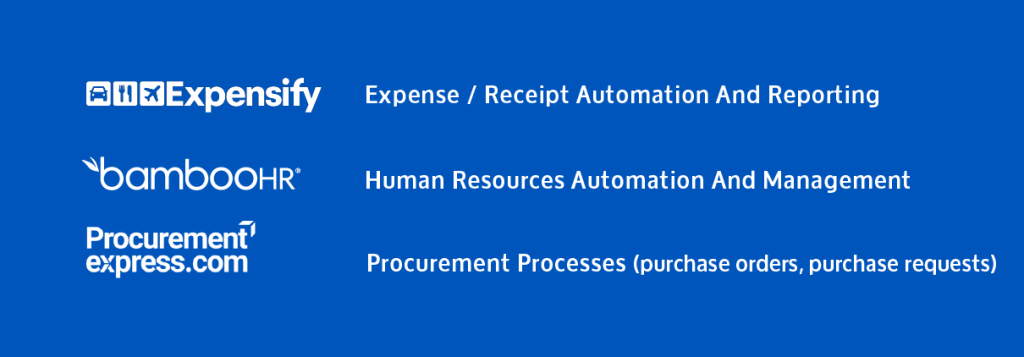
We will categorize each tool by the processes it automates.
Finance / Expense Automation and Reporting
Expensify is a finance and operations software tool that can help you automate accounting, reimbursements, budgets and expenses, and manage operational aspects such as facilities, assets and benefits.
Alternatives: Freshbooks, SAP Concur, Emburse Certify, Zoho Expense, Rydoo
- The Collect plan is $5 per user per month. This plan allows users unlimited “smart scan” receipt uploads, automatic mileage tracking, automatic expense categorization and report submission, automatic syncing with your accounting software
- The Control plan is $9 per user per month. This plan includes the same features in the Collect plan, with the added feature of multi-level approval workflows.
- Free trial: Yes, 6 weeks
Human Resources Automation and Management
BambooHR is a software solution to help HR departments to automate all aspects of the employee lifecycle such as onboarding, performance management, benefits administration, time-tracking, employee records and more.
Alternatives: Zenefits, Cezanne, Zoho People
- The Essentials plan is $6.19 per employee per month and includes basic features such as benefits administration, standard access levels, standard workflows and approvals, and an employee directory.
- The Advantage plan is $8.25 per employee per month and offers the same features as the Essentials plan plus onboarding, audit trails, integrations and API, custom workflows and approvals, and custom access levels.
- Additional add-ons include time-tracking modules and performance management.
- Free trial: Yes, 7 days
Procurement Processes (Purchase Orders, Purchase Requests)
With ProcurementExpress.com, set up and manage budgets, purchase orders and requests, set up approval routing and get more control over the procurement process.
Alternatives: Procurify, SpendMap, eRequisition
ProcurementExpress.com Pricing:
- Pricing starts at $25.00 per month, per user.
- Free trial: Yes
Enterprise Automation Software: Higher Flexibility with Lower Costs
Point solutions do have advantages and are an appropriate solution for certain situations. For example, if you’re a startup and don’t have any established processes, it makes sense to use a ready-made point solution for business needs like expense reimbursement or leave approval. With few employees, the costs are manageable and you can simply sign up and go since you’re willing to conform to the way the software already works.
But, if you’re a bit larger, have established workflows in the organization, and are focused on high productivity, low costs and setting up your business to scale, we recommend you consider an alternative approach. Unless you have only one or a few business processes to automate (which is unlikely), an enterprise automation (all-in-one) solution is more cost and time effective. Here’s why:
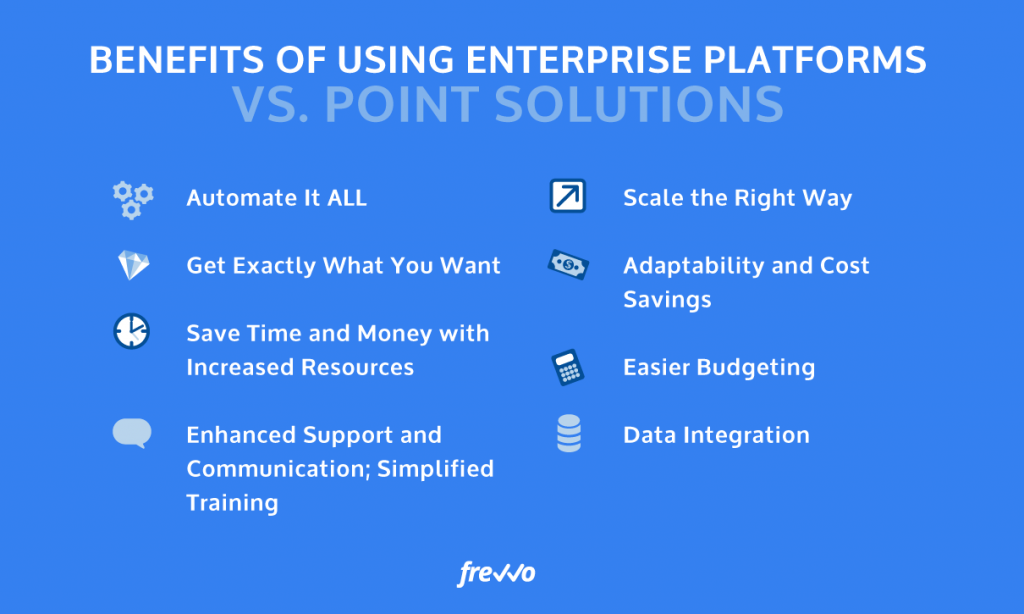
Automate It ALL
How many manual processes (managing paper forms) does your business run? Automating all of them would require multiple point solutions and you still wouldn’t be able to fully automate your business since each business has custom use cases and differing needs. So you are paying money for solutions, without addressing all of your business use cases.
Enterprise platforms address all of your business process automation use cases under one roof with the ability to digitize any process.
Get Exactly What You Want
Get digital forms and PDFs that look exactly like your existing forms or create entirely new designs – it’s up to you. What’s more: you can customize your digital workflows to perfectly match the processes of your organization, no matter how complex they are. With a good enterprise solution, you can do things your way rather than trying to shoehorn your processes into a point solution’s way of doing things.
Save Time and Money with Increased Resources
Automation is supposed to save resources, yet having multiple point solutions can be wasteful. The reason is that point solutions dictate what you need for your business, not the other way around. For example, one of the tools above offers travel, expense, and invoice tracking. But what if you only need travel because you are tracking invoicing with another tool? You are paying for services you are not using.
Enterprise platforms offer automation for all of your business process tasks. One tool can eliminate most (if not all) of your business’ manual tasks, saving you time and money.
Modern platforms tend to offer incredibly easy-to-use visual experiences that don’t require expensive coding or I.T. resources, making them suitable for even the smallest organizations.
Scale the Right Way
Scaling with inefficiencies can rob you of productivity (and money). Inefficiencies that are not corrected will be magnified as you grow and only get costlier to rectify. Multiple point solutions create more silos, which weakens one of the most important advantages of automation. Managing these solutions and the employees who use them equates to more inefficiencies, complexity and workarounds.
This is why we recommend avoiding siloing your business information since it has more potential to create isolated and inefficient processes. Bringing your data together under one roof with an all-in-one enterprise automation solution will give you a strong foundation on which to scale.
Enhanced Support and Communication; Simplified Training
A single, comprehensive solution equates to consistent support and simplified training because you will only need to train your employees once. Since everyone is using the same tool, any department can cross-train, instead of being dependent on only a few people who know how to use their department’s tool (i.e. accounting department with finance tools).
In addition, collaboration is more efficient and unified because it happens inside one software platform, instead of siloed across multiple tools. Business departments now come together under one platform, enhancing inter-office communication and partnership.
Also, if issues arise, you will work with only one support team to resolve them, not 3-5+ at the same time which contributes to a more complex workflow and wasted time.
Adaptability and Cost Savings
Your business needs will shift as you grow. Your software will need to shift with you; however, this is difficult with multiple point solutions. The purpose of automation is to save your business time and money, not add more complexity and costs.
Enterprise solutions are known for adaptability. Any shifting process can be addressed with one piece of software (quick, easy and painless) so you don’t have to service multiple solutions—or worse—purchase yet another one.
Easier Budgeting
Most point solutions charge by user license. As your user numbers shift, it can be difficult to budget the cost of automation, when you’re working with multiple vendors and different pricing models, user counts, or renewal criteria for each.
With enterprise and integrated software solutions, you pay a single fee, deal with a single pricing model, and work with a single vendor. With simple scheduled payments, you can more efficiently budget now and plan for future costs as your company expands.
Data Integration
Many point solutions lack integration capabilities and they’re often purely cloud-based so you can’t share your data and sync to your internal systems to fully automate your processes. In this case, it will require your IT department to create a workaround to help your point solution communicate with your systems which costs time, labor and money. Some point solutions offer an API (Application Programming Interface) but this is typically associated with the higher-priced or enterprise-level plans and requires skilled I.T. resources.
Enterprise solutions come with the ability to integrate all of your current programs—in one place. No need to switch back and forth between programs and search for your data in siloed locations. If it becomes essential, you can sometimes even download and install the software on-premise or install and securely configure connectors to facilitate integration.
Business Process Automation Cost Comparison: Point vs. Enterprise Solutions
If you’re at a crossroads and wondering whether to go with point solutions or an enterprise platform, cost is likely one of your biggest concerns. Point solutions can seem cheaper at the onset, but over time the costs add up since most charge by user license.
Let’s take a look at a cost comparison. To keep it simple, we will compare what it would cost to cover three types of business automation processes: procurement, HR processes, and finances/expenses for point solutions vs. our enterprise automation platform frevvo. We will compare costs for the lowest-priced plan for each solution unless the lower-priced plan did not accommodate the number of users specified. Here’s the breakdown of monthly and yearly costs depending on the number of active users.
Note that this is a representative comparison and your costs may differ depending on your specific needs and which tool you choose. We did our best to estimate the costs to automate your business based on the three main areas: expenses, procurement, and HR, and the three tools we suggested above.
Point Solutions Cost More Than You Might Think
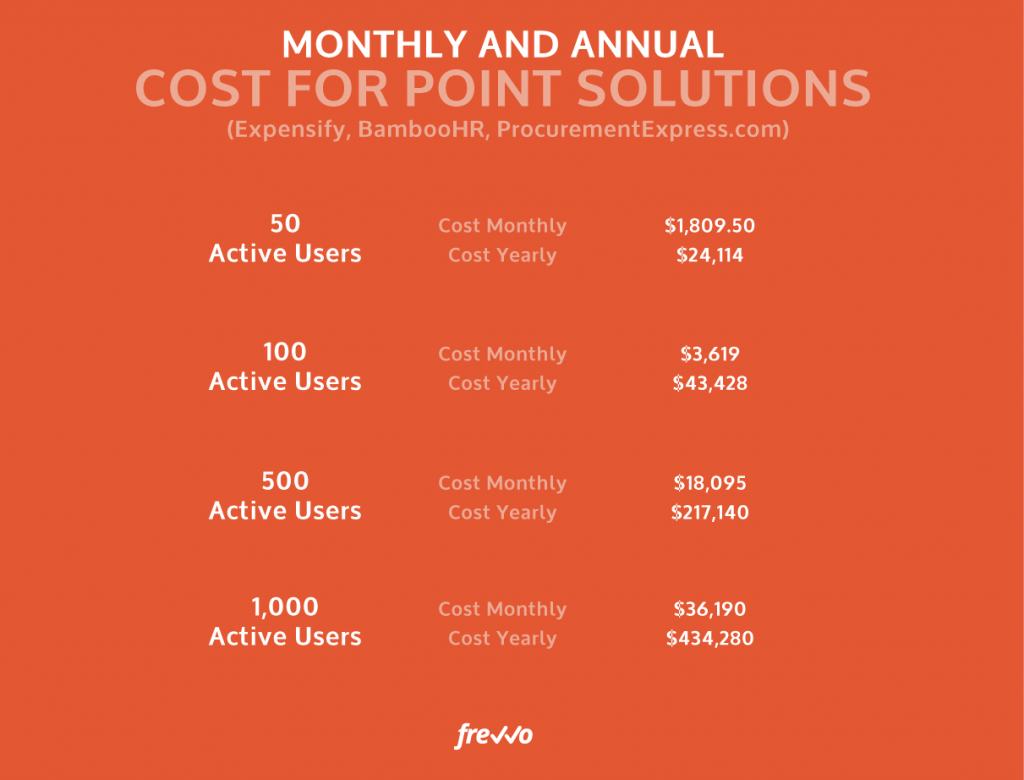
50 Active Users
Point solutions:
Expensify: $5 per user per month = $250
BambooHR: $6.19 per user per month = $309.50
ProcurementExpress.com: $25.00 per user per month = $1,250
Total monthly cost: $1809.50
Total yearly cost: $24,114
100 Active Users
Point solutions:
Expensify: $5 per user per month = $500
BambooHR: $6.19 per user per month = $619
ProcurementExpress.com: $25.00 per user per month = $2,500
Total monthly cost: $3619
Total yearly cost: $43,428
500 Active Users
Point solutions:
Expensify: $5 per user per month = $2,500
BambooHR: $6.19 per user per month = $3,095
ProcurementExpress.com: $25.00 per user per month = $12,500
Total monthly cost: $18,095
Total yearly cost: $217,140
1000 Active Users
Point solutions:
Expensify: $5 per user per month = $5,000
BambooHR: $6.19 per user per month = $6,190
ProcurementExpress.com: $25.00 per user per month = $25,000
Total monthly cost: $36,190
Total yearly cost: $434,280
Note that these point solution costs above do not include the additional costs to train employees on multiple software and revisit the tool’s ability to meet your shifting needs as you scale. In addition, you will likely need more than three point solutions to automate your business processes.
Comparing frevvo vs Point Solutions
In the table below, we look at how much you can save by using frevvo’s enterprise business process automation software instead of using a cobbled-together approach using point solutions.
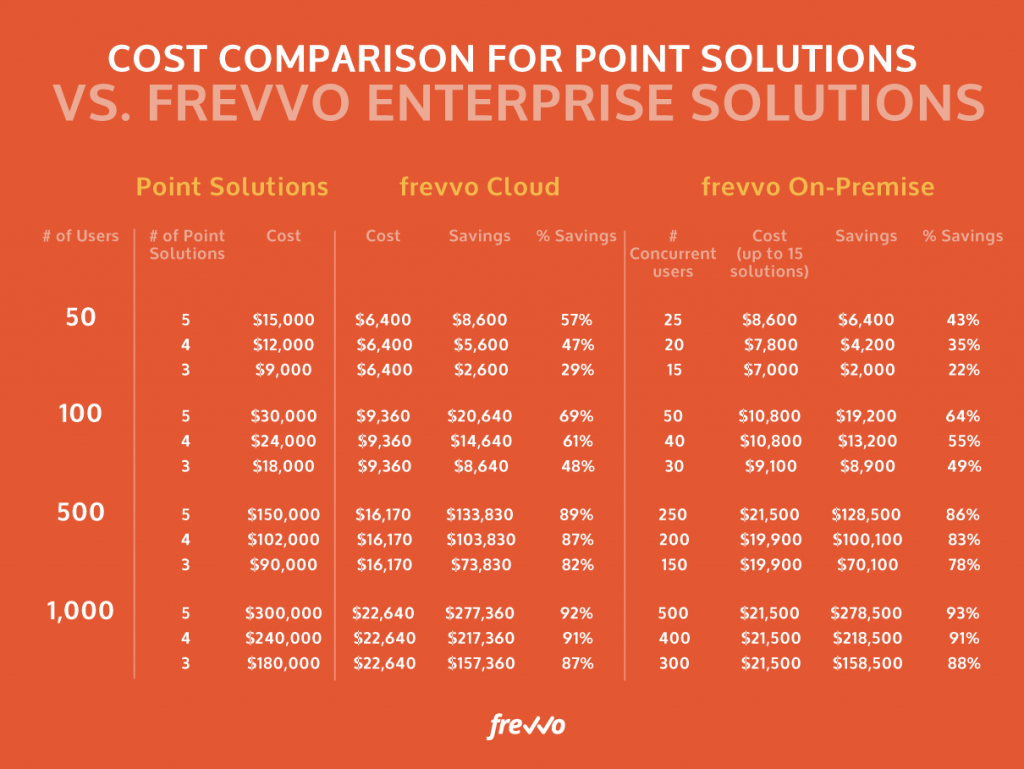
We’ve calculated these costs using very conservative assumptions:
- An average cost per user of $5 per point solution—which is a low estimate based on the examples above.
- frevvo’s Cloud pricing is based on usage (number of workflows submitted). We’ll assume that each user submits 5 workflows per application per month e.g. 5 expense reports, 5 travel reimbursements, etc. Fewer submitted workflows will reduce frevvo’s cost.
- frevvo’s on-premise pricing is based on the number of concurrent users – typically, one concurrent user license supports 5-10 named users but the table below is more conservative.
Your All-In-One Automated Business Process Solution
frevvo is an all-in-one platform that can automate all of your business processes under one roof. No need for programming, coding or complexity; frevvo’s simple, drag-and-drop editor is easy enough for the novice user to master. frevvo is also mobile-friendly, ADA compliant and it has the potential to digitize any of your business processes.
Keep all of your data in one place and avoid spending hundreds of thousands of dollars over time while reducing inefficiencies and silos in your growing company. frevvo use cases include:
- Employee Onboarding
- Purchase Orders
- Travel Requests
- Vacation Requests
- Invoice Approval
- Expense Approval
- Sales Orders
- And more!
Want to take our all-in-one solution for a test drive? Try us out for 30 days and see how frevvo can simplify your business, save you money and increase productivity.

